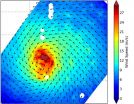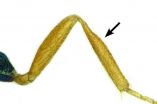(Press-News.org) Until now, researchers believed farming was "invented" some 12,000 years ago in the Cradle of Civilization -- Iraq, the Levant, parts of Turkey and Iran -- an area that was home to some of the earliest known human civilizations. A new discovery by an international collaboration of researchers from Tel Aviv University, Harvard University, Bar-Ilan University, and the University of Haifa offers the first evidence that trial plant cultivation began far earlier -- some 23,000 years ago.
The study focuses on the discovery of the first weed species at the site of a sedentary human camp on the shore of the Sea of Galilee. It was published in PLOS ONE and led by Prof. Ehud Weiss of Bar-Ilan University in collaboration with Prof. Marcelo Sternberg of the Department of Molecular Biology and Ecology of Plants at TAU's Faculty of Life Sciences and Prof. Ofer Bar-Yosef of Harvard University, among other colleagues.
"While full-scale agriculture did not develop until much later, our study shows that trial cultivation began far earlier than previously believed, and gives us reason to rethink our ancestors' capabilities," said Prof. Sternberg. "Those early ancestors were more clever and more skilled than we knew."
Evidence among the weeds
Although weeds are considered a threat or nuisance in farming, their presence at the site of the Ohalo II people's camp revealed the earliest signs of trial plant cultivation -- some 11 millennia earlier than conventional ideas about the onset of agriculture.
The plant material was found at the site of the Ohalo II people, who were fisher hunter-gatherers and established a sedentary human camp. The site was unusually well preserved, having been charred, covered by lake sediment, and sealed in low-oxygen conditions -- ideal for the preservation of plant material. The researchers examined the weed species for morphological signs of domestic-type cereals and harvesting tools, although their very presence is evidence itself of early farming.
"This uniquely preserved site is one of the best archaeological examples worldwide of the hunter-gatherers' way of life," said Prof. Sternberg. "It was possible to recover an extensive amount of information on the site and its inhabitants."
"Because weeds thrive in cultivated fields and disturbed soils, a significant presence of weeds in archaeobotanical assemblages retrieved from Neolithic sites and settlements of later age is widely considered an indicator of systematic cultivation," according to the study.
Early gatherers
The site bears the remains of six shelters and a particularly rich assemblage of plants. Upon retrieving and examining approximately 150,000 plant specimens, the researchers determined that early humans there had gathered over 140 species of plants. These included 13 known weeds mixed with edible cereals, such as wild emmer, wild barley, and wild oats.
The researchers found a grinding slab -- a stone tool with which cereal starch granules were extracted -- as well as a distribution of seeds around this tool, reflecting that the cereal grains were processed for consumption. The large number of cereals showing specific kinds of scars on their seeds indicate the likelihood of those cereals growing in fields, and the presence of sickle blades indicates that these humans deliberately planned the harvest of cereal.
The new study offers evidence that early humans clearly functioned with a basic knowledge of agriculture and, perhaps more importantly, exhibited foresight and extensive agricultural planning far earlier than previously believed.
INFORMATION:
American Friends of Tel Aviv University supports Israel's most influential, most comprehensive, and most sought-after center of higher learning, Tel Aviv University (TAU). US News & World Report's Best Global Universities Rankings rate TAU as #148 in the world, and the Times Higher Education World University Rankings rank TAU Israel's top university. It is one of a handful of elite international universities rated as the best producers of successful startups, and TAU alumni rank #9 in the world for the amount of venture capital they attract.
A leader in the pan-disciplinary approach to education, TAU is internationally recognized for the scope and groundbreaking nature of its research and scholarship -- attracting world-class faculty and consistently producing cutting-edge work with profound implications for the future.
Family members who make major medical decisions for relatives in an intensive care unit (ICU) may suffer posttraumatic stress disorder (PTSD) if they cope by avoiding the situation, according to a new study by scientists at Case Western Reserve University's Frances Payne Bolton School of Nursing.
The patient isn't the only one affected by the long stay, according to Amy Petrinec, from the school of nursing. Family members may suffer, especially if they're required to make medical decisions with long-range consequences they may not understand, or are reluctant to question.
Family ...
(NEW YORK CITY - July 22, 2015) Is it possible that too much iron in infant formula may potentially increase risk for neurodegenerative diseases like Parkinson's in adulthood -- and are teeth the window into the past that can help us tell? This and related theories were described in a "Perspectives" article authored by researchers from the Icahn School of Medicine at Mount Sinai and the University of Technology Sydney and Florey Institute of Neuroscience and Mental Health in Australia, and published online recently in Nature Reviews Neurology.
"Teeth are of particular ...
LOS ANGELES (July 22, 2015) - For the first time, researchers have employed a gene-editing technique involving low-dose irradiation to repair patient cells, according to a study published in the journal Stem Cells Translational Medicine. This method, developed by researchers in the Cedars-Sinai Board of Governors Regenerative Medicine Institute, is 10 times more effective than techniques currently in use.
"This novel technique allows for far more efficient gene editing of stem cells and will increase the speed of new discoveries in the field," said co-senior author Clive ...
WASHINGTON, D.C. - Coral reefs, under pressure from climate change and direct human activity, may have a reduced ability to protect tropical islands against wave attack, erosion and salinization of drinking water resources, which help to sustain life on those islands. A new paper gives guidance to coastal managers to assess how climate change will affect a coral reef's ability to mitigate coastal hazards.
About 30 million people are dependent on the protection by coral reefs as they live on low-lying coral islands and atolls. At present, some of these islands experience ...
Poor schools that have more black and minority students tend to punish students rather than seek medical or psychological interventions for them, according to a Penn State sociologist.
"There's been a real push toward school safety and there's been a real push for schools to show they are being accountable," said David Ramey, assistant professor of sociology and criminology. "But, any zero-tolerance policy or mandatory top-down solutions might be undermining what would be otherwise good efforts at discipline, and not establishing an environment based around all the options ...
BEER-SHEVA, Israel...July 22, 2015 - Ben-Gurion University of the Negev (BGU) and University of Colorado researchers have developed a dynamic "smart" drug that targets inflammation in a site-specific manner and could enhance the body's natural ability to fight infection and reduce side effects.
The uniqueness of this novel anti-inflammatory molecule, reported in the current issue of Journal of Immunology, can be found in a singular property. When injected, it is as a non-active drug. However, a localized site with excessive inflammation will activate it. Most other anti-inflammatory ...
Edward Snowden's leak of classified documents to journalists around the world about massive government surveillance programs and threats to personal privacy ultimately resulted in a Pulitzer Prize for public service.
Though Snowden had no intention of hiding his identity, the disclosures also raised new questions about how effectively news organizations can protect anonymous sources and sensitive information in an era of constant data collection and tracking.
A new study by University of Washington and Columbia University researchers that will be presented next month ...
Amsterdam, The Netherlands, July 22, 2015 - In a large population-based study of randomly selected participants in Germany, researchers found that mild cognitive impairment (MCI) occurred significantly more often in individuals diagnosed with a lower ankle brachial index (ABI), which is a marker of generalized atherosclerosis and thus cumulative exposure to cardiovascular risk factors during lifetime. Interestingly, this strong association was only observed in patients with non-amnestic MCI, but not amnestic MCI. There also was no independent association of MCI and intima ...
Typhoon Halola's strongest typhoon-force winds were located on the northern half of the storm, as identified from the RapidScat instrument that flies aboard the International Space Station.
RapidScat gathered surface wind data on the Typhoon Halola on July 21at 2 p.m. GMT (10 a.m. EDT). RapidScat data showed that the strongest sustained winds stretched from northwest to northeast of the center at speeds up to 30 meters per second (108 kph/67 mph). Strong winds wrapped around the center of circulation from northwest to east to the southern quadrant, while the weakest winds ...
Much to his own surprise, Hannes Baur from the Natural History Museum Bern not only reports on whole two new parasitoid wasps at the heart of Europe, the Swiss Alps and Swiss Central Plateau. While the common discovery usually involves cryptic, or "camouflaging" within their groups species, his stand out. Baur's work is published in the open-access journal ZooKeys.
The insects he describes are visibly quite unique with their body structures. In the case of the Pteromalus briani wasp, its extraordinarily protruding hind legs differentiate it among the whole family. Meanwhile, ...

